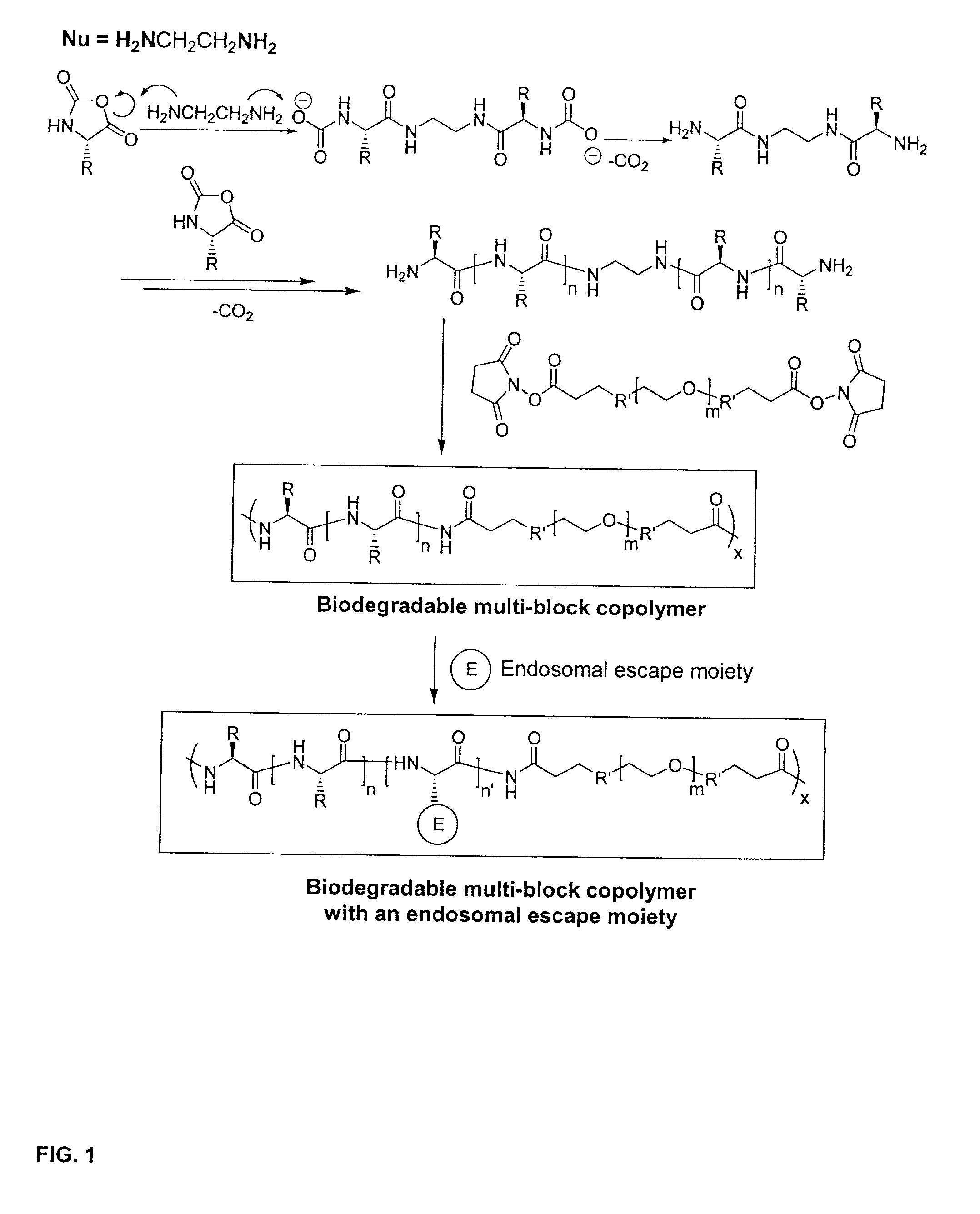Biodegradable multi-block copolymers of poly(amino acid)s and poly(ethylene glycol) for the delivery of bioactive agents
a technology of polyethylene glycol and polyamide, which is applied in the direction of powder delivery, pharmaceutical delivery mechanism, geneetic material ingredients, etc., can solve the problems of host immune reaction, rapid degradation of nucleic acids, and other polyanionic substances by nucleases, and achieves rapid clearance of particles, easy control of particle size and charge density, and effective penetration into tissue
- Summary
- Abstract
- Description
- Claims
- Application Information
AI Technical Summary
Benefits of technology
Problems solved by technology
Method used
Image
Examples
example 2
[0071] This example illustrates the introduction of an endosomal escape moiety into the biodegradable multi-block copolymers of poly(L-lysine) and PEG. The synthetic scheme is illustrated in FIG. 1.
[0072] A predetermined amount of 1.3-dicyclohexylcarbodiimide, N-hydroxysuccinimide and an endosomal escape moiety, N,N-dimethyl-His-OH was dissolved in 5 ml anhydrous methyl sulfoxide (DMSO) and added to a 20 ml vial, equipped with a magnetic stirrer. After stirring for 2 hours, 200 mg of the biodegradable multi-block copolymer (Run No. 2) in 5 ml anhydrous DMSO was added to the vial for the conjugation of the endosomal escape moiety. The reaction was continued for an additional 12 hours at room temperature. The reaction mixture was centrifuged three times to remove the urea byproduct and precipitated into acetone. The solid was washed with Et.sub.2O two times and dried under vacuum overnight. The conjugated copolymers were then dissolved again in double distilled H.sub.2O, centrifuged a...
example 3
[0073] This example illustrates the preparation of a gene delivery composition, according to the present invention, by mixing a biodegradable multi-block copolymer and a pSV-.beta.-gal plasmid DNA (e.g. Promega, Madison, Wis.) in PBS buffer. The biodegradable multi-block copolymer utilized consisted of PLL (degree of polymerization, 11, 26 and 45) and PEG (molecular weight, 1,500) and was prepared as described in Example 1. To study the effect of charge ratio on gene transfer, the plasmid and the biodegradable multi-block copolymer complexes were prepared at charge ratios of 0.3, 0.6, 0.9, 1.2, 1.5, 1.8, 2.1 and 2.4. The control composition contained only the 25,700 molecular weight PLL homopolymer instead of the copolymer. Stable complexes were formed with the copolymer and the aqueous plasmid DNA solution based on the fact that no precipitation or aggregation was observed at wide concentration ranges of the complexes in the PBS buffer. The complex formation of the plasmid DNA and ...
example 4
[0074] In this example, the zeta potential and particle size of copolymers and plasmid DNA, according to the present invention, were measured by a zetapotentiometer. Complexes different in the composition of the copolymer and plasmid DNA were prepared in double distilled H.sub.2O and diluted to 4 ml as the final volume. The sample was subjected to the measurement of zeta potential and mean particle size by a BI-MAS (Brookhaven Instruments Co.) at 25.degree. C., a wavelength of 677 nm, and with the constant angle of 90.degree.. Zeta potential measurement, FIG. 4, also confirmed the results of the gel retardation assy. The copolymer (Run No. 2 in Table 1) was employed to prepare a complex based on a charge ratio between the copolymer and DNA of from 0.5 to 4. Complete neutralization was around the charge ratio of 1. Using the same instrument, the particle size of the complexes was estimated. In the range of the compositions where the amount of copolymer was not enough to effectively c...
PUM
| Property | Measurement | Unit |
|---|---|---|
| molecular weight | aaaaa | aaaaa |
| molecular weight | aaaaa | aaaaa |
| pH | aaaaa | aaaaa |
Abstract
Description
Claims
Application Information
 Login to View More
Login to View More - R&D
- Intellectual Property
- Life Sciences
- Materials
- Tech Scout
- Unparalleled Data Quality
- Higher Quality Content
- 60% Fewer Hallucinations
Browse by: Latest US Patents, China's latest patents, Technical Efficacy Thesaurus, Application Domain, Technology Topic, Popular Technical Reports.
© 2025 PatSnap. All rights reserved.Legal|Privacy policy|Modern Slavery Act Transparency Statement|Sitemap|About US| Contact US: help@patsnap.com



